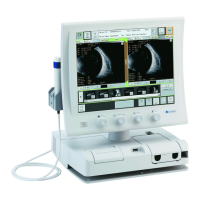3-117
■
3.5 Axial length measurement display function (available only
when AL-4000 is connected)
3.5.1 Setting measurement conditions
a) Setting the eye to be measured, the axial length calculation method, and the
converted sonic velocity
■
Settings made here are only effective for the eye
currently selected. Settings cannot be made for both
eyes simultaneously. Complete necessary settings for
each eye.
Select the eye to be measured from the following 5 options according to the
patient’s eye.
Select the material of the implanted IOL in the case of an eye with IOL.
Phakic eye
Select this for a normal eye or when the crystalline lens nucleus is
comparatively soft, such as an eye in the initial stage of cataracts.
Dense cataract eye
Select this when the crystalline lens nucleus is comparatively hard,
such as an eye with dense cataracts, and it is difficult to take
measurements in the mode for an eye with initial stage cataracts using
an echo reflected from the back of the crystal lens.
Aphakic eye
Select this in the case of aphakic eyes.
IOL eye: Acrylic resin/Silicone/PMMA/user setting
Select this when an IOL is implanted in the patient’s eye.
“Anterior chamber depth” and “lens” are not measured for an aphakic eye
and “lens” is not measured for an IOL eye.
The instrument may not recognize waveforms on the back of the crystal
lens due to multiechoes in the crystal lens in an eye with dense cataracts.
Eye to be measured Axial
length
ACD
(anterior
chamber
depth)
Lens
Phakic eye (Average acoustic
velocity, divisional acoustic velocity)
〇 〇 〇

